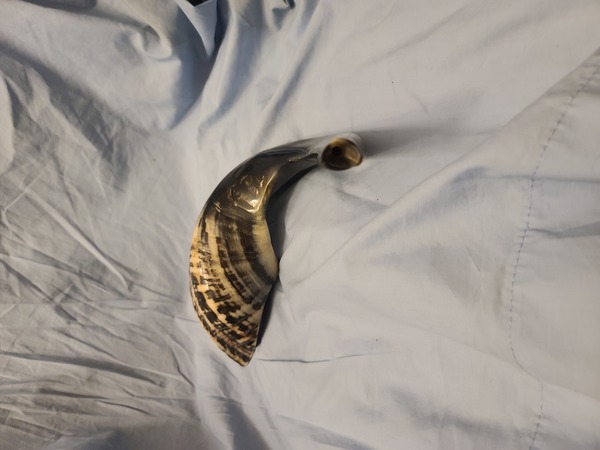
Baltimore Recorders.org
About Shofar

The shofar is the traditional horn used in Jewish religious ceremonies. It has an integrated mouthpiece, like a mute cornetto, and is played like a trumpet. Ashkenazi and Sefardi groups make shofarim from a ram's horn. Yemeni groups make shofarim from the horn of a kudu, which is longer than the ram's horn. The instrument pictured here is made from a ram's horn.
The shofar is blown on Rosh Hashanah, the new year, as well as on the morning of each weekday during the month preceding Rosh Hashanah, Elul. Maimonides writes that the sounding of the shofar is symbolic of being a wake-up call. The sound is associated with moaning or high pitched whimpering. In ritual use, there are three types of calls on the shofar: tekiah, shevarim, and teruah.
Tekiah is a single long blast. I have heard this played as a long note on the tonic connected to a short note on the next higher partial.
Shevarim are three connected short notes. These are typically played low-high, low-high, low-high. This has been likened to the sound of moaning.
Teruah are many short staccato notes, typically nine. These begin on the tonic, and the remaining notes on the next partial. This has been likened to the sound of whimpering.
The Torah does not specify how the horn should be sounded. In the Talmud it is written that each teruah must be preceded and followed by a tekiah. The word teruah is used three times in the Torah with respect to the new year, thus it was decided that the teruah should be sounded three times. There was then debate as to whether or not teruah should be sounded as a teruah or as a shevarim. It was decided that to ensure that all possibilities were covered, combinations of the three different types of calls would be used:
- tekiah-shevarim-teruah-tekiah (abbreviated TaShRaT)
- tekiah-shevarim-tekiah (abbreviated TaShaT)
- tekiah-teruah-tekiah (abbreviated TaRaT)
On Rosh Hashanah the shofar is blown four times during the service. After the Torah reading there are two blessings related to the shofar. Then the TaShRaT is played three times. This is followed by the TaShaT being played three times. Finally the TaRaT is played three times.
During the silent Mussaf prayer, TaShRaT, TaShaT, and TaRaT are played one time after each of the three main blessings. When the Cantor repeats the prayer, the calls are repeated as well.
After the Mussaf prayer TaShRaT, TaShaT, and TaRaT are played. This tradition dates back to the Geonim.
In all there are 100 calls. (There are 4 for each TaShRaT, and 3 each for TaShaT, and TaRaT. There are 3 TaShRaT, TaShaT, and TaRaT prior to the Mussaf, making a total of 30. There are another 30 during the silent Mussaf prayer, and 30 during the repetition of the Mussaf prayer. Lastly there are 10 after Mussaf.)
In addition to ritual use, the shofar has been used in music. Edward Elgar's oratorio The Apostles uses the shofar in its orchestration. Although it is played offstage it can be heard prominently at the beginning of The Dawn section.
The shofar was used in the soundtrack to the film The Ten Commandments, as well as during the nativity scene in Ben Hur. Jerry Goldsmith broke free of the shofar's biblical stereotype with his use of it in the soundtrack to Planet of the Apes. He then went on to use it in the score to Star Trek V The Final Frontier, as part of the Klingon theme. Samples of The Ten Commandments' track were reused in The Return of the Jedi as the sound of horns use by the Ewoks. It has been continued to be used the scores of films. It was used in the End of Days (1999) and The Skeleton Key (2005) Contrary to popular belief the shofar was not used in the score for the movie Alien. That movie used the sound of a conch shell.






Web design copyright 2015 Michael Berger